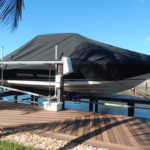Storing your boat outside during winter is not as easy as towing it out of the lake and moving it onto your lawn. In winter conditions and long periods of storage, your boat can experience significant wear and tear. It can also lead to pricey and serious repairs once spring and summer come around.
How to store a boat outside in winter? To properly store and protect your boat for the winter, follow these 11 steps:
- Use a Cover
- Change Oil
- Spray Fogging Oil
- Lubricate the Steering Device
- Replenish the Coolant
- Take out the Drive Belts
- Detach the Battery
- Conceal Exhaust Ports on Inboard Boats
- Fill the Gas Tank
- Mind the Interior
- Wax and Wash
Improperly storing a boat during the winter can also lead to mold as it is exposed to hail, sleet, snow, and rain. Another common issue is pests that may chew up the engine wiring and interior and make your boat their new home.
Read on to learn more about how to store your boat outside in winter so that it is well-protected from the elements.
Also, take a look at this popular boat cover on Amazon that would be perfect for protecting your boat all winter:
Click here to see it on Amazon.
How to Store a Boat Outside in Winter?
When first considering how to store a boat outside in winter, decide where you will store it, including:
- Backyard
- Dry Outdoor Boat Storage Facility
- Portable Shelters
- Shrink-wrapping
Backyard
Most boat owners choose to store their boats in their own backyard to save money since they won’t have to pay any storage fees. However, there are more cons than pros when you choose to store your boat in your backyard. Here are some:
- Some neighbors do not allow storing boats in your own driveway because of the neighborhood agreement. If you do not follow this agreement, you could face penalties.
- Exposed to pests, molds, elements, theft, and vandalism.
- Requires having a pricey boat cover. Note also that a water-resistant tarp is not applicable for winter.
- Takes up yard space.
- Can be an eyesore.
Dry Outdoor Boat Storage Facility
If you don’t have space for your boat at home, then an outdoor boat storage facility is your next option. Each parking spot is typically shielded with a roof to provide some defense against the elements.
So, dry outdoor boat storage is ideal when you don’t have enough storage space in your backyard. Your boat stays near the dock and may not need transportation. Outdoor boat storage facilities are usually for smaller boats.
Portable Shelters
While portable shelters typically last for a number of years, you will have to assemble and dismantle this yourself. Additionally, you will need to get rid of the excess weight of snow build-up to avoid the canopy from falling down.
The disadvantage of portable shelters is that you have to store your seats and other small items inside your home; otherwise, your boat may be damaged by pests.
Shrink-wrapping
A specialist typically installs this type of outdoor covering. The method involves using a heat gun to shrink the top of the film barrier to provide waterproof protection.
How to Prepare Your Boat for Winter Storage
Once you’ve decided where you will be storing your boat for the winter, follow these 11 tips for preparing your boat for winter storage.
1. Use a Cover
Cover your boat to keep it from dirt and moisture. Covering your boat will ensure that it will be all set and ready to go when the warmer months are back.
2. Change Oil
Any liquid that leaks into your oil will damage the engine; therefore, changing the filter and flushing out of the oil is necessary so that there will be no liquid residue. After flushing the old oil out, new oil should be added in.
3. Spray Fogging Oil
You should spray ‘fogging oil’ on your boat’s carburetor or over the spark plug opening (look into your manual for guidance). Doing this will make your engine’s mobile parts safe during the cold season.
4. Lubricate the Steering Device
Lubricating the steering and other control devices will ensure that these will move easily when it’s time for you to take your boat out and have some water adventures. Ensure that the seams are coated sufficiently with lubricant or grease.
5. Replenish the Coolant
Get rid of the current coolant and then flush it with water. Fill with fresh antifreeze to prevent parts of your engine from freezing and to protect them from weathering.
6. Take out the Drive Belts
When kept under rigidity for a long time, your drive belts may crack under pressure. So, it is recommended to release or to take out the drive belts completely before placing your boat in storage.
7. Detach the Battery
Do not let your battery deplete and discharge over the wintertime. Detach the battery and load it with distilled water. Charge the battery every so often to check if it’s ready to run when you attach it back to your boat.
8. Conceal Exhaust Ports on Inboard Boats
Some inboard-powered boats have huge exhaust portholes where bugs can get in and chew up your engine parts. You can use tapes to cover these holes.
9. Fill the Gas Tank
To avoid damaging your gas tank, you should fill it with gas. Note that condensation can develop in an unfilled tank and can damage it if the moisture freezes. Gasoline additive will ensure your gas is ready to use if it’s time to use again.
10. Mind the Interior
Electronics are at risk during extremely cold conditions, which is why you should remove them in your boat during the winter season. Not only electronics but organic materials, such as leather, canvas, and fabric, should be removed as well.
Moisture can create mold and mildew on these items. You should also drain the water tanks and pour antifreeze throughout the water pipes.
11. Wax and Wash
Clean up your boat inside and outside, and then coat the body with wax. The wax will prevent your boat’s body from rusting when stored outside during winter.
Possible Winter Disasters That Can Happen to Your Boat
Broken Boat
If you decide to store your boat in the marina, make sure to do some checking up, even if the marina has the proper insurance. You should know that the boat should be appropriately blocked so that it won’t collapse.
In general, for a 26 feet boat, there should be two supporting platforms on each side, but if your boat is huge, then additional support is required.
Remember that the weight of the boat is planted on its keel and should be supported by solid blocks; otherwise, your boat will get busted even if the blocks are in the right place. The boat’s weight needs to be equally divided to avoid all the weight from resting in one particular section.
Make sure to check your boat, especially after heavy rain, because it can lead to switching in the load. Loads may no longer be evenly distributed, causing a broken boat.
Falling Down Boat Cover
Some boat covers may not withstand the weather elements. It is a very common problem for the boat cover to collapse. This will, of course, leave the boat exposed. Make sure to get a boat cover that is well supported and tied down.
Bad Wrapping
Many boaters often do more damage than good when they wrap up their boats during the cold season. By using only that regular blue tarp in covering your boat, you’ll run into problems. If you don’t put some blanket or any sort of padding over an outboard’s cowl, your boat will be in danger if your tarp touches with it.
Tarps are rough and can scrape your boat, and when they swing around because of the wind, it will surely leave a mark on your boat. And the same issue can happen if the tarp touches fiberglass.
Fire
Make sure not to leave a lightbulb or space heater on, just to keep things warm and dry. Bulbs can generate an outburst if fumes develop. If the bulb comes into contact with combustible items, it can generate fire. So leave the lightbulbs and space heater off to avoid a tragic fire from occurring when you’re away.
Sinking
Boat sinkings are, of course, a complete disaster that can be avoided with simple checks. Many sinkings happen when water seeps in slowly through equipment or parts that lay below the waterline.
There are two ways to prevent this boat from sinking woe; one is to always check your boat, especially after a snowfall, and two is to ensure that the boat has sufficient power coming from well-charged batteries or a Shore Power System so that the pumps will keep working if water will start coming in.
Another winter hazard to boats stored in the water is the blowing up of hoses. The water will freeze if it stays in a hose.
When the temperature plunges, you’ll never know if something is going to freeze solid and burst. To avoid this from occurring, shut down all the seacocks (valves) before the freezing temperatures set in.
Conclusion – How to Store a Boat Outside in Winter?
In summary, how to store a boat outside in winter? To properly store your boat for the winter, follow these 11 steps:
- Use a Cover
- Change Oil
- Spray Fogging Oil
- Lubricate the Steering Device
- Replenish the Coolant
- Take out the Drive Belts
- Detach the Battery
- Conceal Exhaust Ports on Inboard Boats
- Fill the Gas Tank
- Mind the Interior
- Wax and Wash
Winter season is over, and you’re ready to be in the water with your boat again! But wait, before transporting your boat to the lake, you should check first the registration of your boat and make sure it’s not yet expired.
For insurance purposes, make sure to take down any available identification numbers for both your trailer and watercraft. You should also take pictures of your vessel and any other prized items before storing them, especially inside shared storage facilities.
If you’re storing your boat longer than two months, take out the battery and keep it in a cool and dry place. If you’ll store it longer than six months, use a battery charger to ensure that the battery has sufficient load to operate when you want to take the boat out and use it.
Always check your boat’s owner’s handbook for safety purposes and complete instructions for boat towing and storage.
Related reading:
Best Boat Cover Material Plus Our Top 5 Covers
Best Winter Boat Cover – Our Top 7 Picks








![Boat Floor Replacement Plywood [Best Options] boat floor replacement plywood](https://boatinggeeks.com/wp-content/uploads/2021/07/boat-floor-replacement-plywood-150x150.jpg)
![Read more about the article Sea-Doo Boat [Jet Boat Specs and Review]](https://boatinggeeks.com/wp-content/uploads/2021/03/Sea-Doo-boat-300x200.jpg)

![Read more about the article Small Craft Advisory [What Is This Wind Warning?]](https://boatinggeeks.com/wp-content/uploads/2021/07/small-craft-advisory-300x200.jpg)